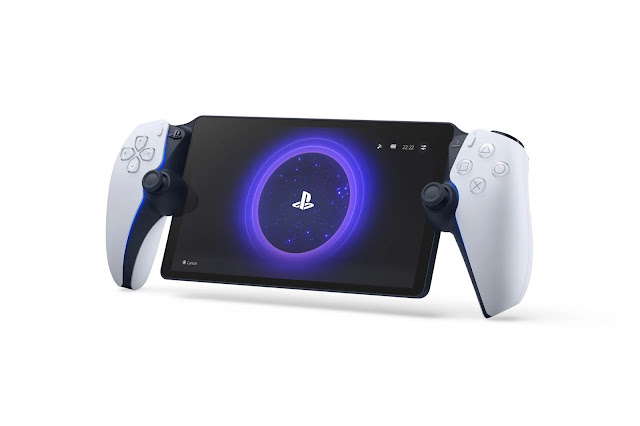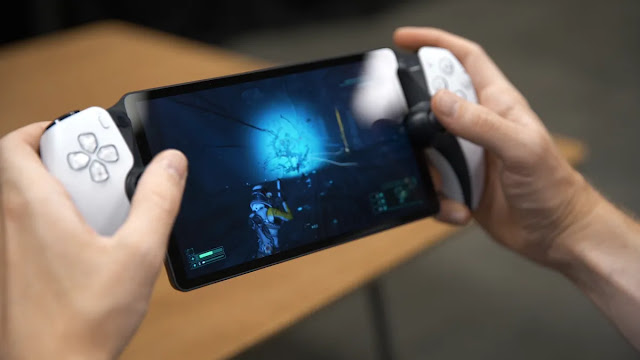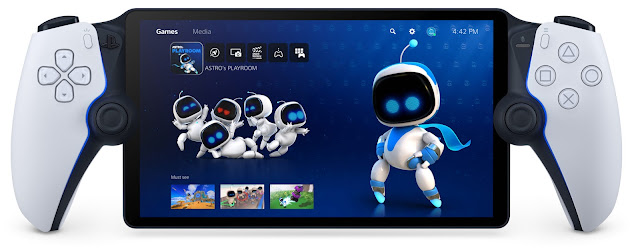PS5 PLAYSTATION PORTAL REVIEW: SONY’S APPROACH TO handheld gaming can be somewhat baffling. The PlayStation Vita was a decent device that didn’t catch on like its predecessor, the PlayStation Portable, but fans still held out hope that a successor might be on the horizon. That was especially true after the Switch reinvigorated the handheld market. Instead, we got the PlayStation Portal.
The Portal is an attempt to compete amid the renaissance of gaming handhelds. Functionally, however, it has little in common with any of those devices. Instead of installing games on it and playing them anywhere, you can only stream games from your PlayStation 5 on the Portal.
Streaming is possible via your home Wi-Fi or the internet, as long as you have the bandwidth, but your console has to be on and online for it to work—acting as a server.
For just $200, it would be one of the cheapest handhelds you can buy, if not for the fact that you need a console that costs at least $400 for it to work. This raises the question: Who is this for, exactly? To my surprise, there might be a market for this.
Gaming, (Somewhat) Untethered
The biggest appeal of devices like the Switch is that you can play your games anywhere. On a plane, at a rooftop party, at a picnic table next to a basketball court under a freeway overpass.
It’s an enticing pitch, and I’ve personally used my Switch in a lot of those situations, but I don’t spend much time at a trendy rooftop party or on a plane. Most days, I just want to play games on my couch or in my bed.
When I want to play Spider-Man 2 but don’t want to be in the living room, the Portal lets me chill in bed with my game. It’s even handy if I want to play some games in the living room while my partner watches a show on TV. It's like the idea behind Nintendo's Wii U, but it works.
Well, sort of. The Portal streams your entire PS5 interface, like a remote PC desktop app—menu and everything. If the TV your console is connected to is on, you’ll see the same thing on the Portal that you see on your TV.
This means that you cannot play a game on the handheld while someone else uses the PlayStation to watch a show on Netflix. It’s fully mirrored. Also, most media apps are blocked on the Portal, so you can’t use it to watch TV either.
It only plays games, and only when you have a good internet connection. Sony recommends a minimum of 5 Mbps, and preferably 15 Mbps, but in my experience you’ll want more (if possible).
Oddly, the Portal can only stream games that are installed locally on your PS5. The library of games that you can stream to your PS5 (with a TV) via a PS Plus Premium subscription cannot be streamed to the Portal screen. Sony should allow players to use the Portal as another connection point for its game streaming service, but that’s not possible right now.
A Controller, in Twain
PS5 PLAYSTATION PORTAL REVIEW: The most striking aspect of the Portal is also one of its greatest strengths: It’s basically a typical DualSense controller, sliced right down the middle, with a screen stuck in between. This means any game you play on the Portal was designed for the controller in your hand.
There’s no need to remap buttons to work with a controller or use a trackpad to approximate a mouse, like you have to with most of the Windows-based gaming handhelds.
There is one minor exception, however: the touchpad. The regular DualSense controller has a clickable, swipeable touchpad in the middle. The Portal’s touchscreen approximates these features, but in an awkward way. Tap the screen with your thumb near the control sticks, and small rectangles on either side will appear to show you areas the touchscreen treats as the touchpad.
In Spider-Man 2, you can double-tap these areas to access the menu or use swiping gestures for shortcuts (like swiping left to access the Friendly Neighborhood Spider-Man app, or swiping up to access the camera). In my experience, these gestures were nearly as fast as the regular touchpad, but they feel awkward.
It’s a small compromise, but considering the nightmare I’ve had trying to play games on some PC-based handhelds, this is a minor annoyance. Still, touchpad-heavy games will annoy you, like Alan Wake II.
In Alan Wake II, you need to click the touchpad to access “The Mind Place” but double-tapping the touchscreen didn’t work. Nothing did. A core mechanic was simply inaccessible. This is likely a bug that will get fixed before long, and Alan Wake II was the only game I experienced it in, but it’s verification that there can be compatibility problems. Other Spider-Man games and Horizon Forbidden West all worked fine.
Screen and Batteries
PS5 PLAYSTATION PORTAL REVIEW: The 8-inch LCD screen is remarkably attractive, with solid black levels and support for up to 1080p Full HD video at 60 frames per second (and since it’s streaming your games, you probably wouldn’t want much more than that or you’d run into bandwidth issues). There’s no Bluetooth support for headphones, but you can connect a pair via a 3.5-mm jack on the bottom or using PlayStation Link-enabled headphones.
Battery life is also solid, with around eight hours of playtime on a full charge. However, unlike the Switch, Steam Deck, or most other gaming handhelds, battery life shouldn’t fluctuate based on what game you’re playing. Streaming eight hours of Spider-Man 2 isn’t all that different from eight hours of Hades, which gives the Portal a moderate battery advantage if your goal is to play AAA games (in your house away from the TV).
Streaming Stress
PS5 PLAYSTATION PORTAL REVIEW: The most strenuous bottleneck for the PlayStation Portal is around its bandwidth needs. I feel pretty comfortable saying that Sony’s recommendation of a 5-Mbps minimum is too low for anything but the simplest games. You’ll want to clear the 15-Mbps threshold if you can. If you’re playing action games with a lot of fast movement, streaming speed and stability matter.
The Portal only supports Wi-Fi 5–not Wi-Fi 6E or even Wi-Fi 6, which is slightly disappointing, given its reliance on a steady network connection–but that is sufficient. The Portal doesn’t have a built-in tool to test its internet speed, but when using it on my home Wi-Fi, connected to the network my PS5 was on, I expected minimal disruptions.
It was able to stream most games smoothly (most of the time), but when I got to some combat-heavy portions of Spider-Man 2, the stream occasionally collapsed into a muddy mess. This is likely because compressed streaming video doesn’t like lots of chaotic movement.
Games like Horizon Forbidden West and Miles Morales also stress the stream with camera movement and snow effects over the environment. Pair that with the need for hyper-fast response times from the controller, and it’s a huge win that it works smoothly at all (most of the time). Game streaming has come a long way. The Portal can’t overcome the inherent instability or finicky nature of Wi-Fi, but it’s about as reliable as it can get.
There Is Another
PS5 PLAYSTATION PORTAL REVIEW: Sony’s PS Remote Play app is free. If you already have a laptop, tablet, or phone (if you’re reading this, I’m going to guess you do), you don’t technically need the Portal at all. WIRED reviewer Jaina Grey uses the app on an iPad with a paired PS5 controller.
The Portal is a tad more convenient than the Remote Play app. For example, Jaina usually has to turn on the PS5 manually to begin streaming, but the Portal will remotely activate my PS5 without turning the TV on. And the Portal has a nicer screen than many devices you might use Remote Play on.
The Portal’s $200 price may be its saving grace. It’s still priced like a luxury item, but it’s just convenient enough to be worth the investment if it meets your specific set of needs.









0 Comments